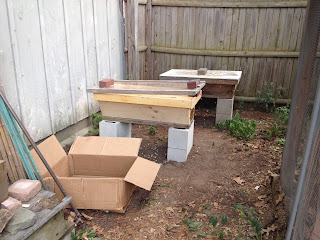Catching a Swarm for Our Second Hive
Things have calmed down here considerably since this weekend’s bee tornado, when our colony decided to split and swarm to create a second group of bees. Once they settled down and found their queen, they all clustered up on a sheltered post of our grape arbor:
This is a lot of bees, and they wouldn’t stay there forever. Their next job was to look for a new place to build comb for a hive — a hollow log would be nice, but it’s just as likely that they would find a hole in a wall and build their nest in a house or garage.
That’s not exactly good publicity for honeybees when it comes to the neighbors, so our job was to catch that swarm and give it a new home. To do that, I dug an old box out of the recycling bin and donned my bee suit to grab those bees and give them some shelter before the sun set. Kirk was called in to work, so I had to do it myself. This would have been better as a two-person job, since climbing on a chair and holding that box in one hand while scooping bees with the other wasn’t easy.
The bees daisy-chain themselves together, though, so you can grab a giant scoopful of them and get lots at once. I grabbed two big handfuls before they got mad and I had to walk away. After they calmed down a bit, I managed to get another couple scoops before one of them stung me through the leather glove.
I was done after that! The rest would have to find their way into the box by following the pheromones put out by their sisters.
Side note: Baking soda paste works really well on a bee sting:
It neutralizes the acidic bee venom and stopped the pain and swelling quickly. Unfortunately, I washed it off before bed, and by morning my hand was very swollen and itchy.
When the sun came up the next morning, the bees in the box were already very active, and there were plenty of scouts out looking for a new place to live — notably poking around our gutters and soffits, so Kirk got right to work on building a second top bar hive.
Here you can see that I also used a pot to catch this later handfuls of bees, since by then the box was too unwieldy to hold up to the post. By the afternoon most bees had abandoned the pot and the post for the box.
When the hive was finished, we were ready to put the bee suits back on and inspect the old hive (it’s fine) before carrying the box of bees over to the new one:
That big box held two to three times as many bees as you’d get in a little package, and it wasn’t nearly as easy to work with. We managed to dump most of them in, but there were still plenty in the box. We left the box out for the rest of the day so they could find their way home:
It’s been a few days, and everything seems fine from the outside with our new hive. It’s unlikely that these bees will be able to make it through the winter since they have to build all new comb and try to fill it with honey in just a couple months, but I suppose they could get lucky with a late frost or something. It will be interesting to watch them get started and to see if they keep their queen or raise a new one. Even if they don’t make it, having an extra hive on hand will probably be useful for any future swarming activity — next time we’ll be prepared!








Comments
Post a Comment